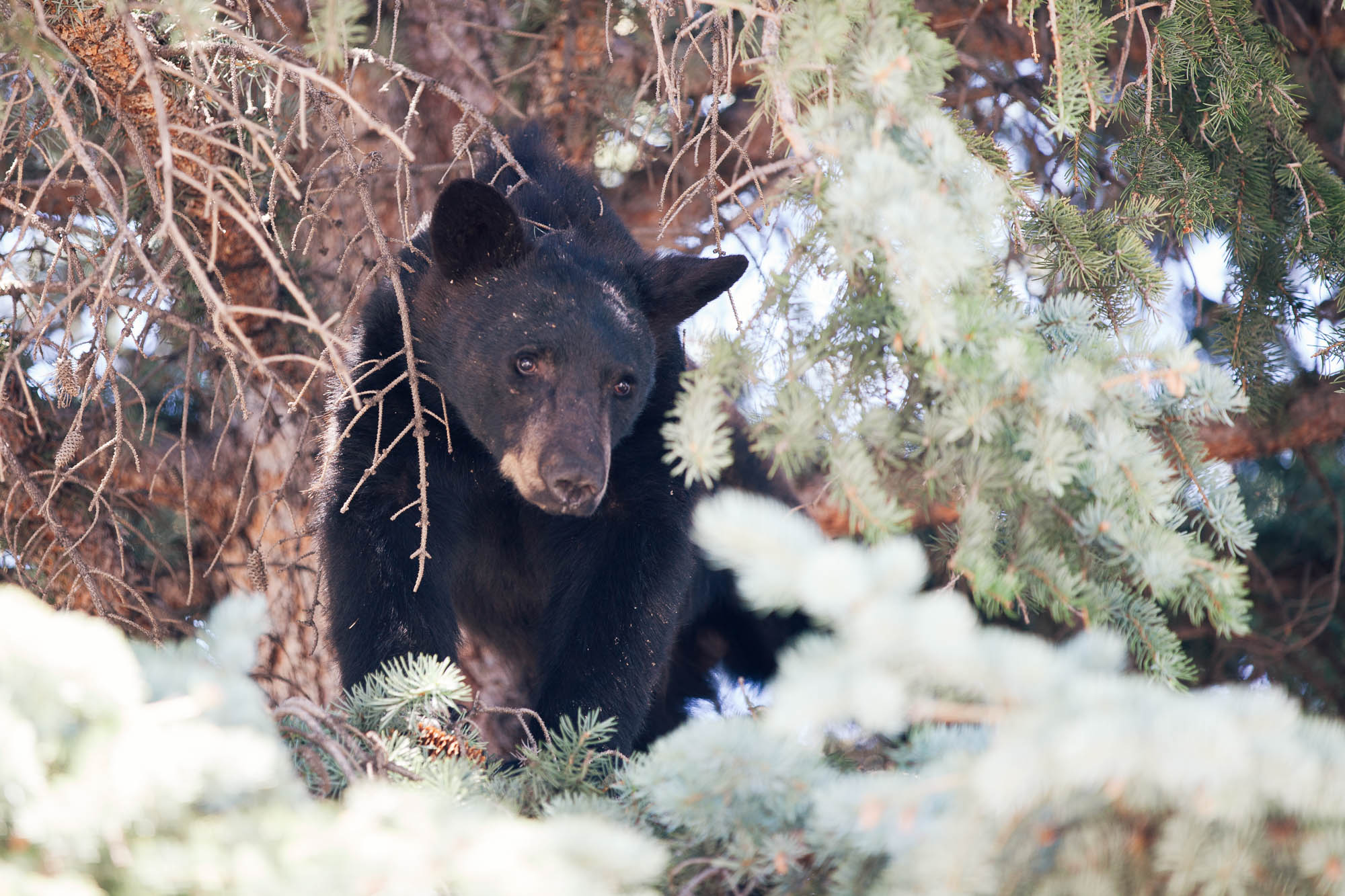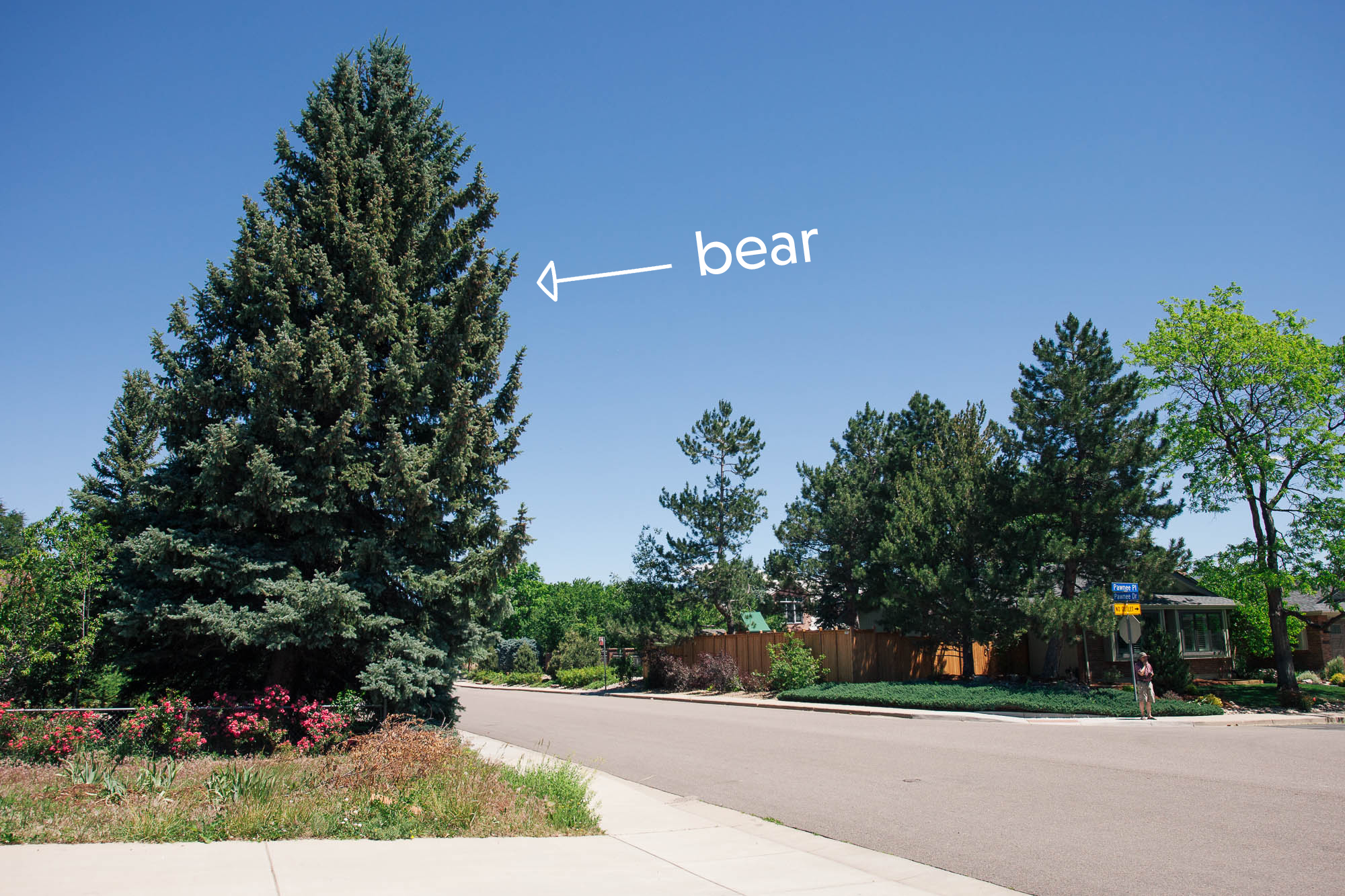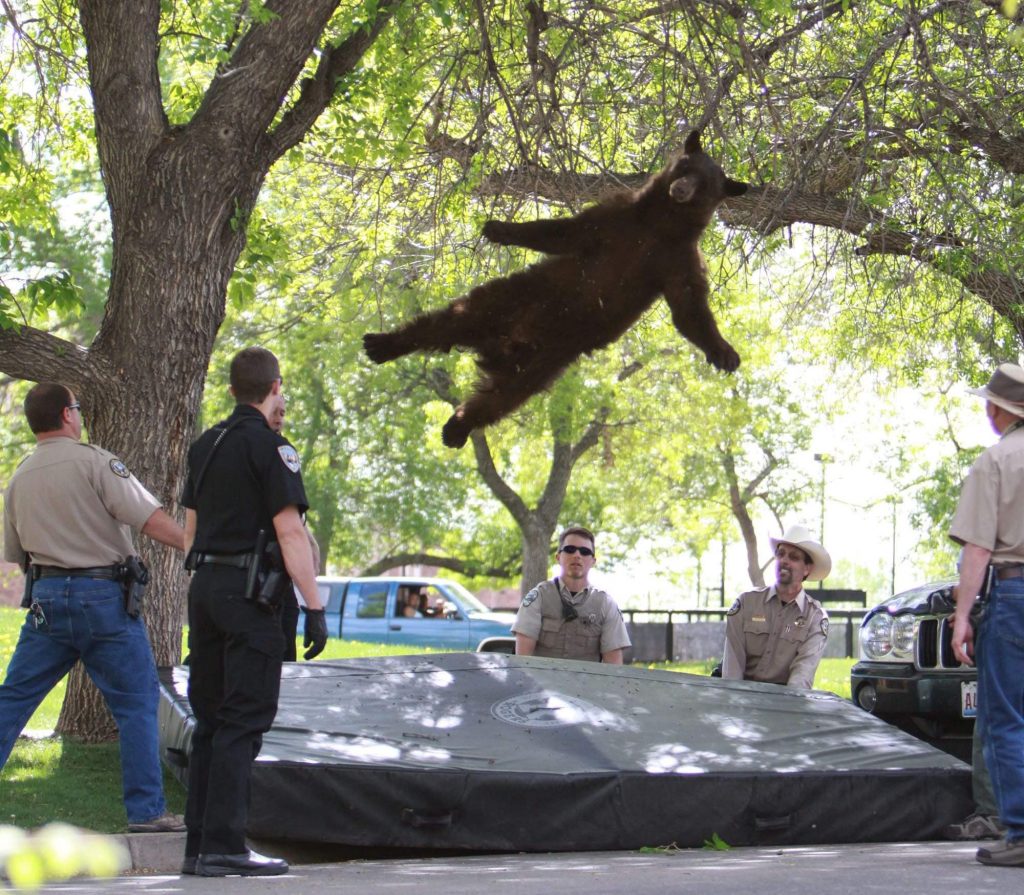Does Boulder have a bear problem? … Or do Boulder’s bears have a people problem?
One might say that the Boulder community is rolling out a red carpet for bears. Not even just bears, but other adaptable species such as coyotes, red fox, raccoons, mule deer, and even mountain lions. Here in Boulder, numerous attractants serve as an open invite into town for animals like these. Western Boulder neighborhoods in particular provide wildlife with a quick commute from the foothills to a rather extensive menu: ripe fruit, bird feeders, pet food, greasy outdoor grills, unsecured trash, and for the bolder species like mountain lions and coyotes, small livestock and off-leash pets.
Black bears are opportunists. The majority of their natural diet is plant-based, but in an urban landscape, anything goes. Bears that reside nearby human communities will often meander into town in search of the easiest, fattiest foods. They want to burn the least amount of energy possible in order to consume the highest number of calories. In her Living with Bears Handbook, Linda Masterson explains that in order for a bear to get those necessary 20,000 calories a day, he or she would need to eat 672 acorns, 78 pounds of blueberries, nearly 25,000 tent caterpillars, or ONE 7-pound bird feeder filled with black oil sunflower seeds. If you were the bear, would you want to spend your energy foraging all day long, or would you meander through town for some easy human-provided food?
Video courtesy of Colorado Parks and Wildlife
Videos courtesy of Boulder resident, Rob Gennet
 Following the path of a black bear via strewn trash. Photo courtesy of Boulder Bear Coalition
Following the path of a black bear via strewn trash. Photo courtesy of Boulder Bear Coalition
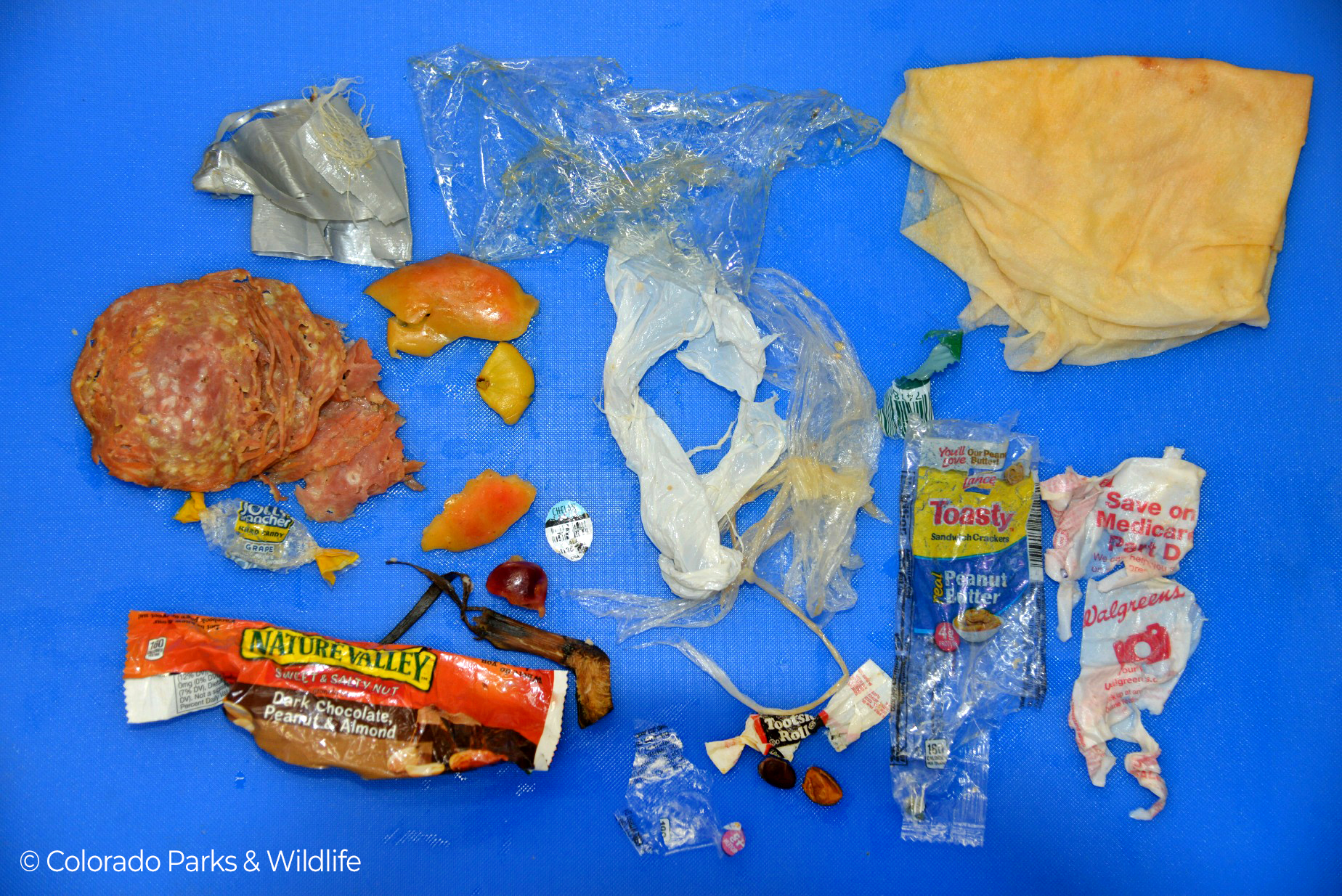
Stomach contents of male bear #352, euthanized in north Boulder July 2018 after repeatedly getting into trash and demonstrating aggressive behavior to humans.
In Boulder’s urban areas, the most popular place for a black bear to find food is in a person’s trash or compost bin.
It doesn’t matter how much “food” is actually in the bin: if it smells like food, then the bears will sniff it out. Bears that break into a person’s waste bins aren’t subtle; one might hear them knocking the cans around and tearing bags apart in search of tasty treats. After the damage is done, residents will find their trash strewn all over the place, with paw prints or claw marks present, and bear scat nearby.
Other attractants that prove to be popular for black bears are things one may not even consider. In Boulder specifically, bears tend to make frequent visits to residents’ bird feeders and unharvested fruit like apples, pears, chokecherries and plums. Additionally, items like beehives, backyard chickens, and even goats will serve as easy meals. Beyond food, cities also provide excellent shelter for wildlife, and an escape from rivaling animals. Considering that black bears prefer to be solitary creatures, they try to avoid any overlap of territories. Sometimes that escape is in a person’s quiet backyard, or at the top of a neighborhood cottonwood tree where they can snooze the day away. So, why not let the bears feast on these delicious treats and seek shelter near our homes? What’s wrong with helping them gain that necessary weight for winter hibernation?
A fed bear is a dead bear
It’s true that black bears are risk-avoiders; they steer clear of danger at all costs. Regardless of their shy demeanor, one must remember that black bears are very large, strong, wild animals classified as carnivores. Healthy adults can weigh anything from 100 to more than 600 pounds. Black bears rarely show aggression towards humans, and we want to keep it that way. When a person makes him or herself look big and makes a lot of noise, the bear should run away. We want these large omnivores to maintain their natural fear of humans so they will steer clear of us and act like wild bears.
The moment a black bear loses its anthrophobia, or fear of humans, is the moment conflicts arise with people. “Habituation” occurs when a bear becomes accustomed to urban life and making a regular diet out of human-provided foods such as trash. When a bear becomes habituated, it no longer sees humans as a threat, and it can become aggressive.
Colorado’s Two-Strike Policy
Colorado Parks & Wildlife, the government agency which manages all wildlife throughout the state, implemented a statewide “Two-Strike” Policy as a way to manage black bears and keep human communities safe.
Capturing the bear for relocation or euthanization is a last resort for wildlife officers in Boulder, and typically happens when other efforts such as hazing or “bearsitting” prove to be ineffective or when the bear becomes a public safety risk.
Strike 1: Tranquilize – tag – relocate
A bear that appears in an inappropriate location (for example, too far into town) or engages in episode(s) of “nuisance” behavior (multiple visits to town, light property damage, etc.), will be tranquilized by wildlife officers, ear-tagged, and relocated to another area within the state of Colorado.
Strike 2: Euthanization
If that same bear has to be physically dealt with again (tranquilized or trapped due to inappropriate location or nuisance behavior), the bear is killed. It doesn’t matter where the bear is found: if it’s getting into trouble anywhere else throughout the state, it’s an automatic death sentence for the bear. Bears that pose a public safety risk will be put down regardless of whether they have ear tags or not.
It’s a tough call for wildlife managers to make. In communities like Boulder that have a high tolerance of wildlife, officers do their best to avoid having to handle a bear in the first place to give the animal a better chance of survival. Unfortunately for bears that may just be a little turned around and find themselves deep into a city area, any physical management taken on the bear counts as the first strike.
There’s good news, though. You and your neighbors can take action to prevent bears from becoming habituated to urban life. Learn more here >
Relocation of bears is a reactive management tool and does not address the larger reason behind these conflicts.
Black bear relocations must take place within the state of Colorado, and they should be at least 35-60 miles away from where the bear was captured. Otherwise, and this often still does happen, the bruin will come right back to their home range. Juvenile bears tend to have the best chance of successful relocations, as they don’t have an established home range to return to. This is certainly true in the Boulder North District, where CPW District Wildlife Manager Kristin Cannon told me via email that she does have updates for many of the bears CPW has relocated, and
“a majority of adult bears were killed on a second strike after being involved in additional conflict, some were hit by cars, but most of the subadults we didn’t hear from again (whether because they died or stayed on the natural landscape is hard to say).”
Black bears are found throughout the state of Colorado, so it’s important to remember that each county has its own bear populations to manage. When a bear is relocated, it may be dumped in another bear’s territory, get hit by a car, or become another region’s problem bear. Though it certainly has been a powerful management tool and proved successful for many bears, relocation is a reactive management strategy and does not address the larger reasons behind these conflicts. Residents should instead be proactive about removing bear attractants from their property and not allowing the bear(s) to get too comfortable in an urban atmosphere by hazing them away with loud noises and other deterrents.
Community safety
In addition to black bears being killed, habituated bears pose some major concerns for human communities. Keeping in mind these are large, wild, carnivorous animals, habituated bears may become aggressive and potentially harm a person. According to Boulder’s Urban Wildlife Conservation Coordinator, elderly residents and families with young children are especially concerned about physical encounters with bears that make their way into urban areas. Physical encounters with black bears are extremely rare, but not unheard of. In the state of Colorado, only three black bear fatalities have been documented, with the most recent encounter being in Ouray, Colorado in 2009. A 74 year-old woman had reportedly been feeding bears on her property, when one later on mauled her to death.
No black bear related fatalities have been documented within Boulder County. However in 2017, a 19 year-old camp counselor awoke with his head inside a black bear’s mouth while he was sleeping outdoors in Ward, Colorado. The bear dragged the young man roughly 12 feet before he was able to fight it off and safely get away. This goes to show that although these encounters are quite few and far between, they are still worthy of concern. Black bears tend to be rather cautious animals and will avoid humans at all costs, but there’s no telling what could happen when a bear becomes habituated to urban life and loses its natural fear of humans.

A young bear spent 14 hours in a tree one block north of the bustling Pearl Street Mall. 6 bearsitter volunteers, 4 wildlife officers, and 2 police officers worked to keep the crowd at bay and encouraged the bear to stay safely in the tree.

Yearling bear getting into a resident’s bird feeder. Photo courtesy of Kristin Cannon, Colorado Parks and Wildlife.

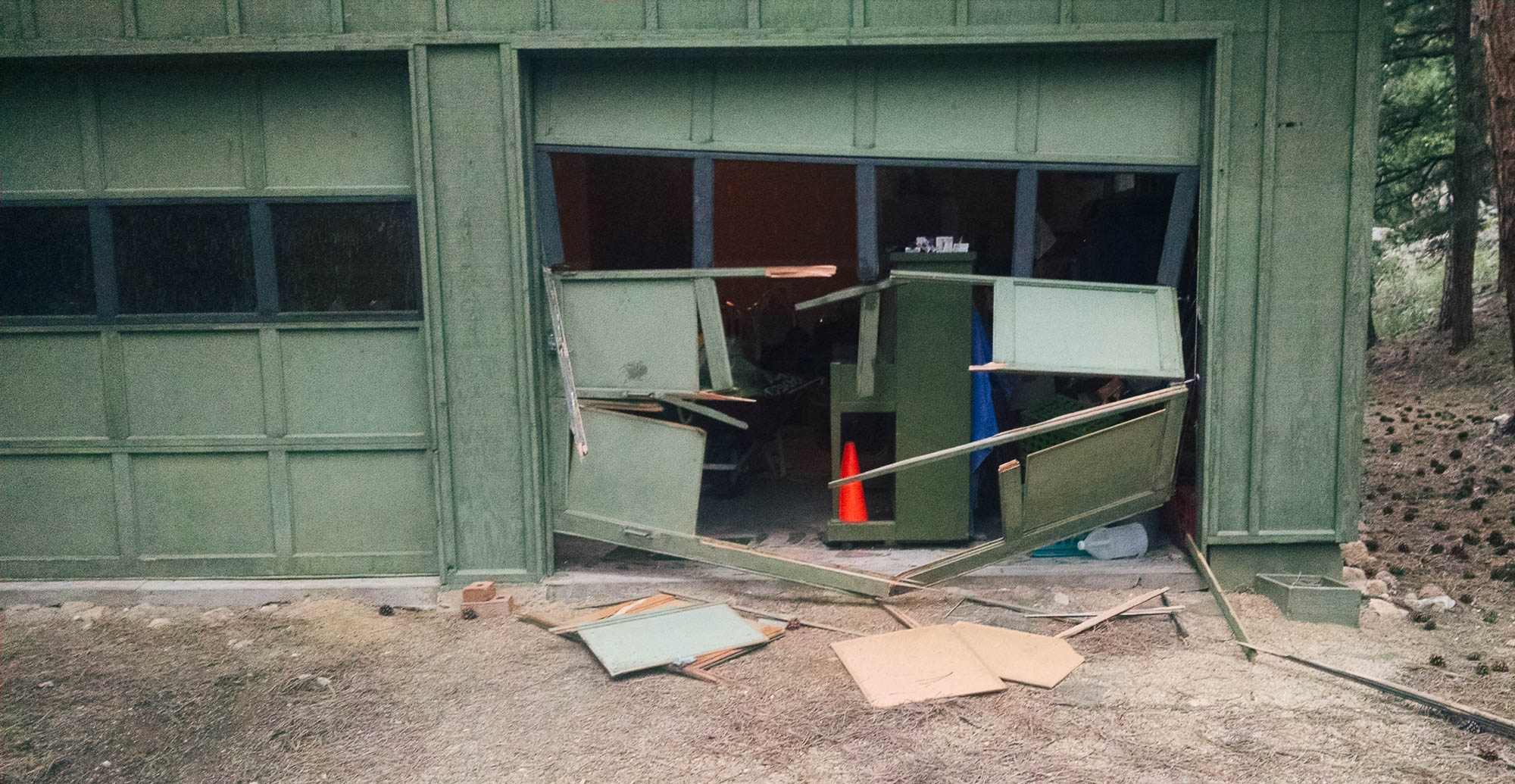
Property damage
Property damage is another concern when black bears wander into human properties. Beyond breaking into trash bins, their strong noses will lead them to other attractants found in a person’s backyard, shed, garage, car, and even inside their home. Bears are extremely intelligent and have been able to open doors and other devices. In Boulder a rumor was circulating that a few smart bears were discovering how to open bear-resistant trash cans, by either prying the top lid back, or learning how to slam the bear-resistant cans onto their side to push a metal pin in and pop the can open. If their meticulous tricks don’t work and the food scent continues to entice the hungry bear, it may choose to use its powerful limbs to rip through a garage door or break a window open.
Home break-ins tend to be more common in the mountain communities west of Boulder, where vacation rentals commonly sit vacant for longer periods of time. According to CPW’s conflict reports, one instance shows a bear breaking into an unlocked house and consuming the entire contents of the kitchen refrigerator, freezer, and garbage. Another bear tore a hole into a person’s shed in an attempt to consume the garbage that was stored inside. After smelling some dog food inside one resident’s attached garage, a bear somehow made its way through a doggy door to consume roughly 30 lbs of kibble. The conflict reports continue on and on throughout the years, detailing just how determined these omnivores can be when it comes to finding food.
Top left: Damage left to an unlocked car after a bear broke in, in search of food. Photo courtesy of Boulder Bear Coalition
Bottom left: One of multiple garages torn apart by a single black bear in Sugarloaf. Wildlife officers believe the bear may have associated garages with food. Photo courtesy of Kristin Cannon, Colorado Parks and Wildlife

